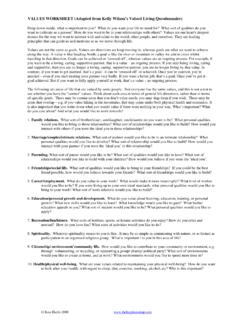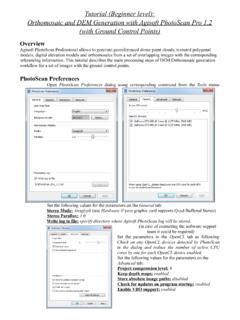Transcription of Data valuation: Understanding the value of your data assets
1 Data valuation: Understanding the value of your data assets02 Data: Could it be your most valuable asset? Increasingly, data assets are the engine driving the total value and growth of modern organizations. As a result, building a framework to discover and realize the potential of your data is critical to increasing the value you provide to shareholders, and to optimizing the future success of your organization. Many companies, however, fail to understand both the value of their existing data assets and the underlying levers that can increase data value . This can mean, in turn, that they miss out on the competitive advantages and shareholder value that their data assets can generate. In order to capture and harvest the value of data over time, organizations must fi rst seek clarity on how to value data as an asset, then follow through with a comprehensive data strategy to drive value enhancement. Whether you re just starting out in developing your framework for data valuation or seeking guidance as you move through the process, Deloitte s experienced Data Valuation practice can work with you to help deliver on the untapped potential of your data assets .
2 Our innovative ValueD platform merges internal and external data to enable global benchmarking of asset values. Data from thousands of transactions worldwide, across industries and asset types, is collected, anonymized, and combined with other third-party data to help clients unlock hidden value and gain deeper insights. Then, our Data Valuation practice provides clients with clear analysis of selected business fi nancial metrics, presented in streamlined, visual reports all based on broad and deep with Deloitte s Data Valuation practice through our value Discovery Lab, companies can explore opportunities to develop three leading value -driving capabilities that highly valued companies do well: Apply a value lens to strategic goals by developing a value architecture a critical blueprint for tying value drivers to strategic objectives and business benefi ts Create a capital decisioning framework to generate the highest and best use of investment dollars Understand how communicating eff ectively and effi cientlycan drive valueData valuation | Understanding the value of your data assets03 Step 4: Explore alternative/future data use casesEvaluate use cases through a valuation lensValuing data.
3 Building a comprehensive frameworkAs with valuing other company assets , valuing data is a multi-phased process, as illustrated in the graphic below. value data in current use casesOnce you ve identified your existing data assets , the next step is to clarify their current use cases and explore alternative use cases that could further your business growth and development. Answering the following questions can help guide the process: What type of data assets do we currently have, and how are we using them? Do our data assets offer us alternative ways to grow our business? How can our data assets help us increase our margins? How can our data assets help us mitigate risks now and in the future?Step 1: Identify/Inventory current data assetsStep 2: Identify data attributesStep 3: Identify current data use casesData valuation | Understanding the value of your data assets04 Evaluating use cases through a valuation lens: Growth, returns and riskAs with other assets within a business, in order to understand the value of its data assets , an organization must understand how data impacts enterprise growth, returns and risks.
4 At Deloitte, our Data Valuation practice can help, as we have extensive experience valuing high-growth business assets including data along these three pivot points, using time-tested models to focus on key drivers of value . Deloitte s Data Valuation practitioners can work with your enterprise management teams to uncover the current and future impacts of your data assets on enterprise growth, returns and risk by examining the following questions:Growth What s the existing enterprise growth story? Is your data being utilized to generate revenue? What are potential alternative use cases for the data? Are there synergies with other assets within the organization?Returns What s the cost to house/maintain the data? What are the organizational and system costs associated with the data? What are the potential earnings generated from the data? Are there third-party commercial revenues associated with the data?
5 Does the internal use of the data produce returns? Risk What are the privacy and data security impacts to the organization ( , data generation, storage, access and dissemination)? Do the risks outweigh the returns associated with certain types of data? Can data be used to reduce the organization s risk by proactively providing insights or to create defensive value "? Can we identify market perceptions of the organization, including data held and retained?Data valuation | Understanding the value of your data assets05 Steps 1 and 2: Identifying current data assets and their attributesOften the first step in any process is Understanding your starting point. For the valuation of data, this first step involves completing an inventory of current data assets and, just as importantly, determining how the organization is currently utilizing its data if it s being used at all. In many cases, we find that organizations are hindered in their efforts to effectively monetize their data because they don't understand where all of their data resides.
6 Uncovering all of the data may require systems to update and maintain any registry of the company s data the data has been identified, management should explore and categorize its key attributes. An Understanding of key attributes can help in the development of any use cases to maximize the data s impact on the organizations growth, profitability and of how data is different and why it matters for data valuation Data may be shareable without any loss of value The value of data changes with use and with specificity Data is perishable, but not depletable Although data value increases when combined with other data, more is not necessarily better Data presents unique security challengesWhat s the state of your data? Attributes that may be used to assess data include: Data quality Relevance, recency, accuracy and type Targetability/depth/selectability For specific data segments Source Governance, collection method, privacy implications Universe/breadth Coverage of audience, trailer data Use case/ROI Substantiated use case Market demand Market and willingness to pay Uniqueness and exclusiveness Availability of similar dataData valuation | Understanding the value of your data assets06 Valuation methodologiesData is similar to other intangible assets .
7 While the attributes of any set of data may be unique, traditional valuation approaches which incorporate growth, profitability and risk elements can be used, along with a strong Understanding of the data s attributes, to value data. These approaches include:The market approach Today, companies are using advanced analytics to more fully understand their data, and to identify ways to license it to third parties. In addition, within various ecosystems, data exchanges are being developed so market participants can aggregate and trade data assets , and participating companies can exchange data to create even more value for their enterprises. As companies continue to mine their data and develop models to transact in this asset category, these transactions can be used to derive market indications of value . As with other assets , value comparability challenges will exist but as markets mature and companies identify more ways to transact, Deloitte believes data transactions will be commonly used to value data excess earnings method (MPEEM) An income-approach methodology that measures economic benefits by calculating the cash flow attributable to an asset after deducting contributory asset charges (CACs), which are appropriate returns for contributory assets used by the business in generating the data asset s revenue and method A method for estimating the value of data assets by quantifying the impact on cash flows if the data assets needed to be replaced (assuming all of the other assets required to operate the business are in place and have the same productive capacity).
8 The projected revenues, operating expenses and cash flows are calculated in scenarios with and without the data, and the difference between the cash flows in the two scenarios is used to estimate the data s from royalty method A method built on the assumption that if the company doesn't own the data asset, it might be willing to license the data from a hypothetical third party who does. In this method, the company would forgo a certain amount of profitability to license the data from a third party over a certain cost approach A method that uses the concept of replacement cost as an indicator of value . The premise is that an investor would pay no more for an asset than the amount for which the utility of the asset could be replaced, plus a required profit/return to incent a third party to replace the valuation | Understanding the value of your data assets07 With-and-without approach$14,000$12,000$10,000$8,000$6,00 0$4,000$2,000 Cash flowsYear12345678910$0 Without cash flowsWith cash flowsValue of dataSteps 3 and 4: Identifying current and alternative/future use casesThe process of data valuation can uncover new use cases, ranging from new commercial applications to alternative and defensive uses for data.
9 The valuation approaches in each case will be determined by the existing and potential uses of data. Use case 1: InternalThe eff ective use of data can allow businesses to separate themselves from the pack, gaining fi rst-mover advantage to become leaders and disruptors in various of the dataExample:A life insurance company analyzes weekly proprietary mortality claim data, which it packages for internal use by its sister company, a wealth manager. The company then becomes highly profi table using the data in a sales-lead and pricing methodology:When a company uses its data to disrupt a market and gain fi rst-mover advantage, the with-and-without valuation methodology can be deployed to understand the impact of the data on the value of the business. Although this method requires a high degree of discretion, it can be a good approach to help frame the data asset s potential range of values. As with most data valuation methodologies, the process of developing the forecast assumptions and valuation inputs often gives management the best insights.
10 Using this approach, management utilizes the existing business model to develop the with scenario: this is the business value with the data asset in place, utilizing its forecast as a marketplace , management develops the without scenario: a hypothetical second scenario forecasting what a competitor might do to catch up in the marketplace. This forecast assumes all the assets of the company, or a similar competitor, are in place except the data asset, and also makes certain assumptions about required capital expenditures and operating expenses. Finally, subtracting the values in the with model from those in the hypothetical without model produces a theoreticalvalue for the data valuation | Understanding the value of your data assets08 Example: A retail company analyzes and packages its proprietary customer purchasing data, then provides this information to other third parties for a monthly subscription fee. The company has a defined use case, with an external source of revenue and profit that can be discretely methodology: Common valuation methodologies for this approach include the relief from royalty and the with-and-without methods.












